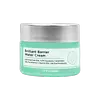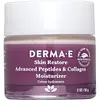What's inside
What's inside
 Key Ingredients
Key Ingredients

 Benefits
Benefits

 Concerns
Concerns

No concerns
 Ingredients Side-by-side
Ingredients Side-by-side

Water
Skin ConditioningNiacinamide
SmoothingPentaerythrityl Tetraethylhexanoate
EmollientPPG-6 Caprylyl Ether
Skin ConditioningSqualane
EmollientIsopentyldiol
HumectantPanthenol
Skin ConditioningCetearyl Olivate
Undecane
EmollientSaccharide Isomerate
HumectantSorbitan Olivate
EmulsifyingGlyceryl Stearate
EmollientBehenyl Alcohol
EmollientBacillus Ferment
Skin ConditioningCeramide AP
Skin ConditioningCeramide As
Skin ConditioningCeramide NP
Skin ConditioningCeramide Ns
Skin ConditioningCholesterol
EmollientCeramide EOP
Skin ConditioningAvena Sativa Kernel Oil
Skin ConditioningSimmondsia Chinensis Seed Oil
EmollientAllantoin
Skin ConditioningNaringenin
Skin ConditioningHydrogenated Lecithin
EmulsifyingGlyceryl Caprylate
EmollientTridecane
PerfumingPanthenyl Triacetate
Sodium Stearoyl Glutamate
CleansingAcrylates/C10-30 Alkyl Acrylate Crosspolymer
Emulsion StabilisingTocopheryl Acetate
AntioxidantGlycerin
HumectantCaprylhydroxamic Acid
Sodium Hydroxide
BufferingTrisodium Ethylenediamine Disuccinate
Dipropylene Glycol
HumectantSucrose Distearate
EmollientWater, Niacinamide, Pentaerythrityl Tetraethylhexanoate, PPG-6 Caprylyl Ether, Squalane, Isopentyldiol, Panthenol, Cetearyl Olivate, Undecane, Saccharide Isomerate, Sorbitan Olivate, Glyceryl Stearate, Behenyl Alcohol, Bacillus Ferment, Ceramide AP, Ceramide As, Ceramide NP, Ceramide Ns, Cholesterol, Ceramide EOP, Avena Sativa Kernel Oil, Simmondsia Chinensis Seed Oil, Allantoin, Naringenin, Hydrogenated Lecithin, Glyceryl Caprylate, Tridecane, Panthenyl Triacetate, Sodium Stearoyl Glutamate, Acrylates/C10-30 Alkyl Acrylate Crosspolymer, Tocopheryl Acetate, Glycerin, Caprylhydroxamic Acid, Sodium Hydroxide, Trisodium Ethylenediamine Disuccinate, Dipropylene Glycol, Sucrose Distearate
Water
Skin ConditioningGlycerin
HumectantMacadamia Ternifolia Seed Oil
EmollientCaprylic/Capric Triglyceride
MaskingStearic Acid
CleansingCetyl Alcohol
EmollientGlyceryl Stearate Citrate
EmollientDimethicone
EmollientHydroxypropyl Cyclodextrin
MaskingPalmitoyl Tripeptide-38
Skin ConditioningAcetyl Hexapeptide-8
HumectantPanthenol
Skin ConditioningPinus Pinaster Bark Extract
AntioxidantGlyceryl Stearate Se
EmulsifyingAcacia Seyal Gum Extract
HumectantTocopheryl Acetate
AntioxidantAscorbyl Palmitate
AntioxidantHamamelis Virginiana Bark/Leaf Extract
AstringentAesculus Hippocastanum Seed Extract
Skin ConditioningCamellia Sinensis Leaf Extract
AntimicrobialChamomilla Recutita Flower
Skin ConditioningSimmondsia Chinensis Seed Oil
EmollientAllantoin
Skin ConditioningXanthan Gum
EmulsifyingPotassium Sorbate
PreservativeSodium Hydroxide
BufferingPhenoxyethanol
PreservativeEthylhexylglycerin
Skin ConditioningParfum
MaskingWater, Glycerin, Macadamia Ternifolia Seed Oil, Caprylic/Capric Triglyceride, Stearic Acid, Cetyl Alcohol, Glyceryl Stearate Citrate, Dimethicone, Hydroxypropyl Cyclodextrin, Palmitoyl Tripeptide-38, Acetyl Hexapeptide-8, Panthenol, Pinus Pinaster Bark Extract, Glyceryl Stearate Se, Acacia Seyal Gum Extract, Tocopheryl Acetate, Ascorbyl Palmitate, Hamamelis Virginiana Bark/Leaf Extract, Aesculus Hippocastanum Seed Extract, Camellia Sinensis Leaf Extract, Chamomilla Recutita Flower, Simmondsia Chinensis Seed Oil, Allantoin, Xanthan Gum, Potassium Sorbate, Sodium Hydroxide, Phenoxyethanol, Ethylhexylglycerin, Parfum
Ingredients Explained
These ingredients are found in both products.
Ingredients higher up in an ingredient list are typically present in a larger amount.
Allantoin is a soothing ingredient known for its protective and moisturizingg properties. Because of this, it is often added to products with strong active ingredients.
Studies show higher concentrations of this ingredient can promote wound healing.
Though it can be derived from the comfrey plant, allantoin is produced synthetically for cosmetic products to ensure purity.
Learn more about AllantoinGlycerin is already naturally found in your skin. It helps moisturize and protect your skin.
A study from 2016 found glycerin to be more effective as a humectant than AHAs and hyaluronic acid.
As a humectant, it helps the skin stay hydrated by pulling moisture to your skin. The low molecular weight of glycerin allows it to pull moisture into the deeper layers of your skin.
Hydrated skin improves your skin barrier; Your skin barrier helps protect against irritants and bacteria.
Glycerin has also been found to have antimicrobial and antiviral properties. Due to these properties, glycerin is often used in wound and burn treatments.
In cosmetics, glycerin is usually derived from plants such as soybean or palm. However, it can also be sourced from animals, such as tallow or animal fat.
This ingredient is organic, colorless, odorless, and non-toxic.
Glycerin is the name for this ingredient in American English. British English uses Glycerol/Glycerine.
Learn more about GlycerinPanthenol is a common ingredient that helps hydrate and soothe the skin. It is found naturally in our skin and hair.
There are two forms of panthenol: D and L.
D-panthenol is also known as dexpanthenol. Most cosmetics use dexpanthenol or a mixture of D and L-panthenol.
Panthenol is famous due to its ability to go deeper into the skin's layers. Using this ingredient has numerous pros (and no cons):
Like hyaluronic acid, panthenol is a humectant. Humectants are able to bind and hold large amounts of water to keep skin hydrated.
This ingredient works well for wound healing. It works by increasing tissue in the wound and helps close open wounds.
Once oxidized, panthenol converts to pantothenic acid. Panthothenic acid is found in all living cells.
This ingredient is also referred to as pro-vitamin B5.
Learn more about PanthenolThis oil comes from the seeds of the desert shrub called Jojoba. It is more commonly known as jojoba oil, a non-comedogenic oil.
Jojoba oil does not contain fragrance and has many fatty-acids, making it a great soothing ingredient.
It also contains Vitamin E, a great moisturizing ingredient. Vitamin E is also an antioxidant and protects your skin against oxidative damage.
This ingredient humectant properties, meaning it helps draw moisture from the air. This helps keep your skin hydrated.
While jojoba has antibacterial properties, it is only able to kill some strains of bacteria.
Studies also show it helps in wound healing. In fact, Indigenous cultures have used jojoba as a moisturizer and to help treat burns for centuries.
Fun fact: Jojoba oil similar to natural human skin sebum, so it has a great effect on dry skin. It is also promising with helping to regulate sebum production.
Due to its fatty acid content, Jojoba oil may not be fungal acne safe. We recommend speaking with a professional if you have any concerns.
Learn more about Simmondsia Chinensis Seed OilSodium Hydroxide is also known as lye or caustic soda. It is used to adjust the pH of products; many ingredients require a specific pH to be effective.
In small amounts, sodium hydroxide is considered safe to use. However, large amounts may cause chemical burns due to its high alkaline.
Your skin has a natural pH and acid mantle. This acid mantle helps prevent harmful bacteria from breaking through. The acid mantle also helps keep your skin hydrated.
"Alkaline" refers to a high pH level. A low pH level would be considered acidic.
Learn more about Sodium HydroxideTocopheryl Acetate is AKA Vitamin E. It is an antioxidant and protects your skin from free radicals. Free radicals damage the skin by breaking down collagen.
One study found using Tocopheryl Acetate with Vitamin C decreased the number of sunburned cells.
Tocopheryl Acetate is commonly found in both skincare and dietary supplements.
Learn more about Tocopheryl AcetateWater. It's the most common cosmetic ingredient of all. You'll usually see it at the top of ingredient lists, meaning that it makes up the largest part of the product.
So why is it so popular? Water most often acts as a solvent - this means that it helps dissolve other ingredients into the formulation.
You'll also recognize water as that liquid we all need to stay alive. If you see this, drink a glass of water. Stay hydrated!
Learn more about Water